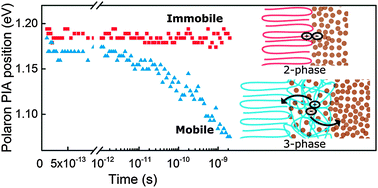The coexistence of intermixed amorphous polymer : fullerene phases alongside pure semicrystalline polymer and fullerene phases provides a plausible explanation for effective charge separation in organic photovoltaic blends by providing a cascaded energy landscape. We sought to test this proposal by spectroscopically tracking charge dynamics in 3-phase blends compared with binary counterparts and linking these dynamics to free charge yields. Our study applies broadband transient absorption spectroscopy to a series of closely related alternating thiophene–benzothiadiazole copolymers in which the tuned curvature of the polymer backbone controls the nature and degree of polymer–fullerene intermixing. Free charge generation is most efficient in the 3-phase morphology that features intimately mixed polymer: PCBM regions amongst neat polymer and PCBM phases. TA spectral dynamics and polarization anisotropy measurements reveal the sub-nanosecond migration of holes from intermixed to pure polymer regions of such blends. In contrast, 2-phase blends lack the spectral dynamics of this charge migration process and suffer from severe geminate recombination losses. These results provide valuable spectroscopic evidence for an efficient charge separation pathway that relies on the 3-phase morphology.

http://pubs.rsc.org/en/content/articlelanding/2015/ee/c5ee01713k#!divAbstract
 Disulfide-Based Multifunctional Conjugates for Targeted Thera...
Disulfide-Based Multifunctional Conjugates for Targeted Thera...
 Chromogenic/Fluorogenic Ensemble Chemosensing Systems
Chromogenic/Fluorogenic Ensemble Chemosensing Systems

















